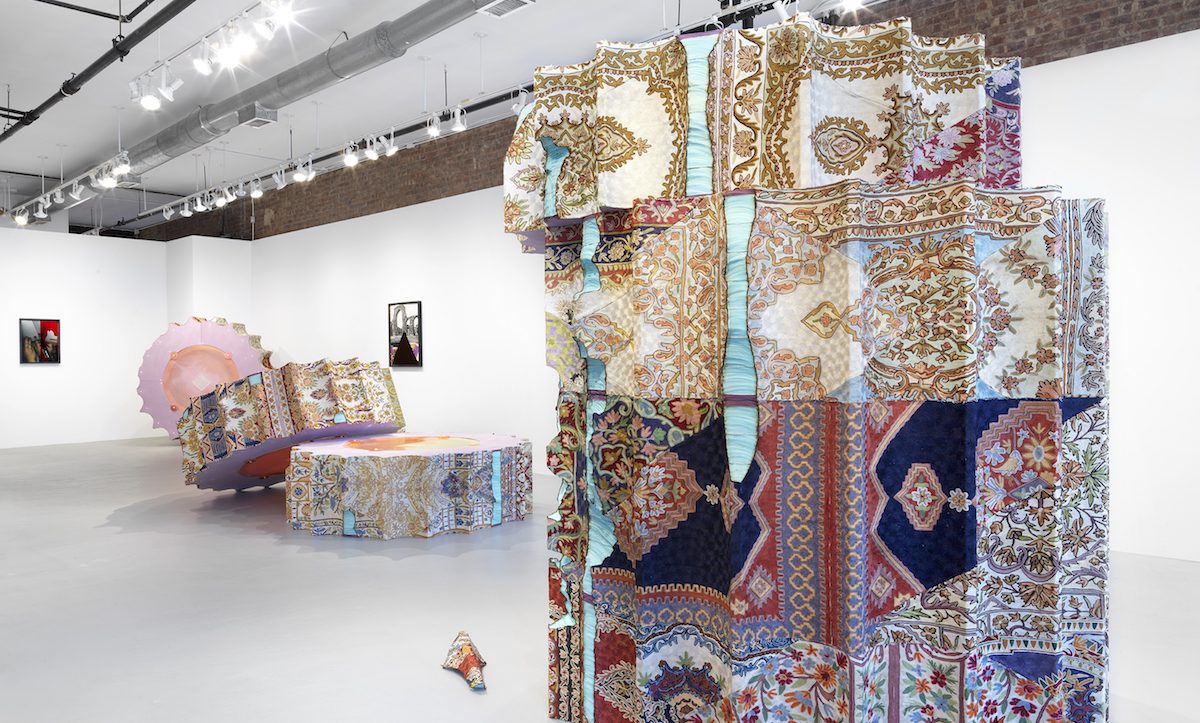Walking into the Simone Subal Gallery on the lower east side, which was once ironically a hub for immigrants, I am taken aback by the beautiful work in front of me. From an aesthetic point of view alone, the sculptures of “Snake Skin,” an installation by Baseera Khan, an artist and a visiting faculty member at Bennington College in Vermont (my alma mater), holds one’s gaze in observation.
Ms Khan’s practice that revolves around the body caught in social, sexual, and economic influences – IF
On closer inspection, I step into her thinking, which provides me with the greater narrative of Ms Khan’s practice that revolves around the body caught in social, sexual, and economic influences historically making the same passes around the sun for thousands of years. The attentively placed sculptures in her “Snake Skin” installation of a shattered 6’ x 14’ single imperial column is inspired by her time in Italy, which is a mecca of ruins. Her fragile existence is no less affected by the structures of political convolution, taking into account her origins as a Muslim woman with an Indian/ Pakistani background, growing up in Texas. This grand construction is symbolic of all nationalities, no less those that began here in the United States. A nation which was once peopled by Native Americans, then usurped by Europeans, lest we forget that the Puritans were escaping persecution in England and consequently sought to keep their religious purity by excluding non-believers in New England.
Ms Khan’s broken pillar is set in formulaic disarray, testifying to the symbolic end of a dominate society, resulting in fragile relics that are hollow on the inside — broken apart by corruption and fragile ideals of the regulatory powers that be. The columns are made from architectural mauve-coloured foam, and they are empty on the inside. Still, they are cloaked with splendidly made Kashmiri silk carpets that were smuggled out of the besieged country specifically for this show. Ms Khan has carved through the rugs with hot wire lending the feeling of time and weathered warn decay with fallen pieces that have cracked off scattered throughout the installation. The symbolic meaning of it is as pertinent as it was a thousand years ago, remarkable on the outside but not solid. Thus they are a built-in hollow tribute to ideals that cannot be sustained indefinitely. Each one of the seven pieces of the majestic structure is sliced; dissected from the whole so the viewer may investigate all sides of the equation.
Surrounding the centrepiece for her exhibition are several chromatic collaged prints made with fragments from the Kashmiri rugs. There are images of ruins, mosques, and cartoons from 1980s issues of an East German magazine called Mosiak meant to jinn up socialist support. Cleverly, Ms Khan includes Indian political revolutionary material drawing parallels between activist agendas of Europe and India. However, the dark side catches consideration when ugly jokes belying racist dogma about Jews, Blacks, and Muslims appear in Mosiak. While trying to make a case for a better world, the cartoons of Mosiak belie the influences of bias, racism, and the religious zeal of hypocrites. Socialism, yes, only for “us”! Angry at the message, Ms. Khan, like so many of “us” who feel insulted and hurt by cruel remarks and insinuations about our origins, draws scribbles on these images. Wanting to erase and blot out the pain of bigotry; of being “othered,” showing the less noble purview of a compromised philosophy when it comes to tolerance and inclusion. These are exciting concepts and carry a weighty visual vocabulary. “Mosiak” Strange truth!
Baseera Khan – Simone Subal Gallery – 131 Bowery 2nd Floor, New York Thru December 22

